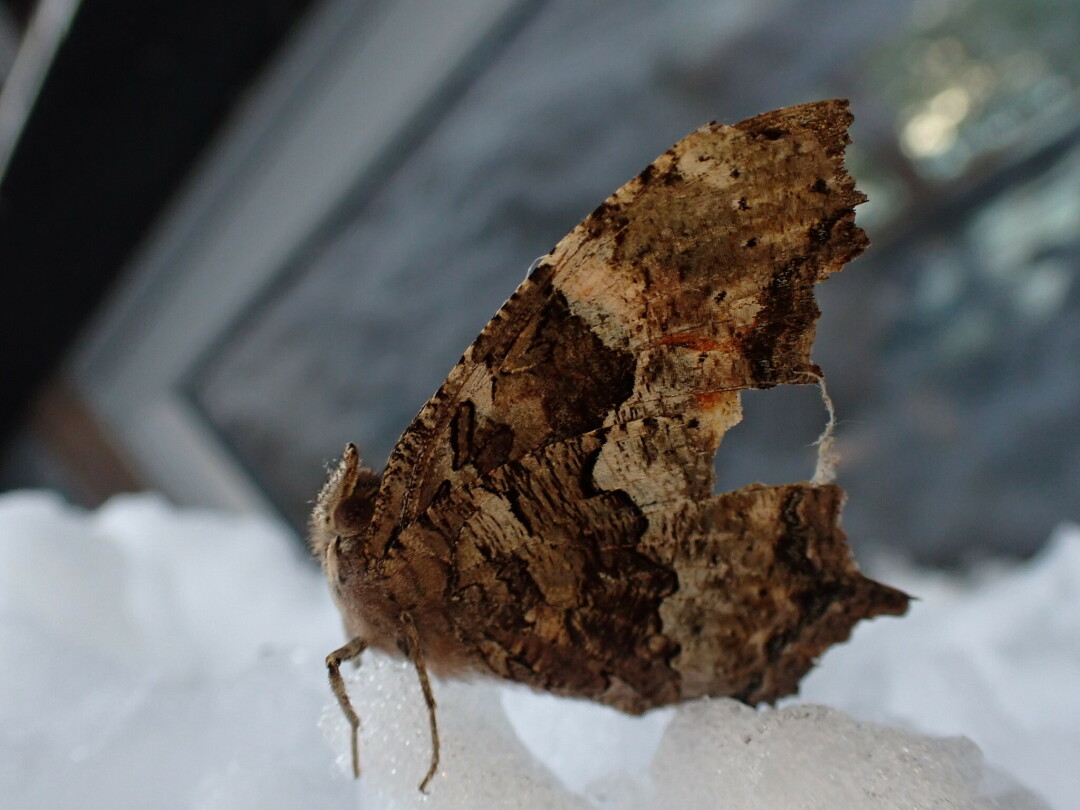News & Articles
Browse all content by date.
 Compton tortoiseshell butterflies overwinter as adults. They are well camouflaged to look like leaf litter, and sip on tree sap when they emerge in spring. This one might be a tad early. Photo by Emily Stone.
Compton tortoiseshell butterflies overwinter as adults. They are well camouflaged to look like leaf litter, and sip on tree sap when they emerge in spring. This one might be a tad early. Photo by Emily Stone.
Now is not the time of year I usually think about butterflies. So the brown, leaf-like shape on the giant snow pile outside my kitchen window caught me by surprise. I had to strap on snowshoes to go check it out in the late afternoon sun.
Lovely shades of brown and cream, combined with the rough line of the trailing edge of the wings would have given this butterfly excellent camouflage against fallen leaves on the forest floor. Even the big notch on the wing, likely removed by a bird’s beak, just served to further disguise the insect’s shape. With temperatures near freezing, the butterfly wasn’t moving.
I crept right up to their face with my macro camera and captured bunny-level fuzz from antennae to chest. Photos uploaded to the iNaturalist website suggested an identification of Compton tortoiseshell, Nymphalis l-album. If it had been warm enough for the butterfly to open their wings, I would have seen beautiful orange and brown markings and scalloped edges.
A closer look at my photos showed only four legs instead of an insect’s typical 6 legs. Compton tortoiseshells are part of the brush-footed butterfly group in which the first pair of legs are small, fuzzy, and tucked up against their body. They are sometimes used to clean the butterfly’s antennae.
As I read more about the Compton tortoiseshell’s life history, their appearance so early in spring began to make sense. The caterpillars of this species munch on aspen, birch, and willow leaves during the peak of summer, and then metamorphose into adults in July. The adults rest and feed throughout the fall, storing up fat but staying in a state of diapause where they don’t become fully reproductive right away.
Like bears, butterflies will enter a hibernaculum in late fall. They might find shelter under shaggy pieces of tree bark, in cracks and crevices, or under the eaves of old buildings. The butterfly I found was very close to the eaves of an old, mossy shed, which seems like a cozy place to hide. Some members of this species may cluster in a group, and others may even migrate south to increase their chances at a warm bedroom for the winter.
When overwintered adults emerge in the spring (usually not until April) they are an incredible 10 months old! In contrast, many species of butterflies and moths only live a few weeks as adults. Compton tortoiseshells survive cold temperatures by being fuzzy, by basking in the sun (which is what the one I found likely was trying to do), and by filling their body with antifreeze.
Compton tortoiseshells get their energy by sipping on tree sap from sapsucker wells, juice from rotten fruits, and scat—instead of relying solely on flower nectar. The flexibility of their diet allows these butterflies to survive throughout the Northern Hemisphere from northern Wisconsin to Alaska, Canada, Romania, Ukraine, the Himalayas and Japan.
They aren’t the only butterfly who overwinters in the adult stage. As I’ve written before, mourning cloaks, eastern commas, gray commas, and red admirals all join that group, as does the famous monarch butterfly. The big difference with the monarch, of course, is that the ones in Wisconsin fly south to Mexico instead of hiding out in the eaves around here.
No matter where the butterflies overwinter, finding shelter is essential. I witnessed that firsthand with a group of Museum members on our trip to the Monarch Butterfly Biosphere Reserve in Michoacán, Mexico, last December. We were amazed by the thick clusters of monarchs clinging to the boughs of oyamel fir trees on the mountain tops. The butterflies choose their winter home to ensure that they stay warm enough to avoid freezing and cool enough to slow their metabolism and conserve limited energy stores.
While it would be almost impossible to count the monarchs individually, scientists estimate the population size by measuring the area turned orange by their wings. The World Wildlife Fund (WWF) and the National Commission of Protected Natural Areas in Mexico (CONANP) just released the winter 2022–23 monarch butterfly population counts: they declined 22% from last year.
Illegal logging in the Reserves is often blamed for the decline in the size of the winter population, but this year, more than half of the tree loss was caused by fires, storms, and pests—all symptoms of climate change.
Dr. Karen Oberhauser, director of the UW–Madison Arboretum, contends that the weather monarchs encounter during spring migration in Texas (happening now!) has the biggest impact on their ability to rebound their numbers through breeding. Summer habitat—reduced since the invention of herbicide-tolerant crops resulted in less milkweed—is also essential.
While we may not be thinking about butterflies during this long winter, they are out there surviving…hopefully.
Emily M. Stone is Naturalist/Education Director at the Cable Natural History Museum. Her award-winning second book, Natural Connections: Dreaming of an Elfin Skimmer, is now available to purchase at www.cablemuseum.org/books and at your local independent bookstore, too. For more than 50 years, the Cable Natural History Museum has served to connect you to the Northwoods. The Museum is closed for construction of our new exhibit: The Northwoods ROCKS! It will open on May 2, 2023. Follow us on Facebook, Instagram, YouTube, and cablemuseum.org to see what we are up to.
| Tweet |


